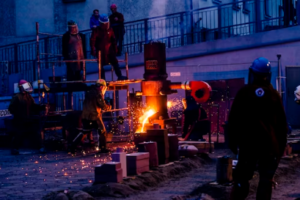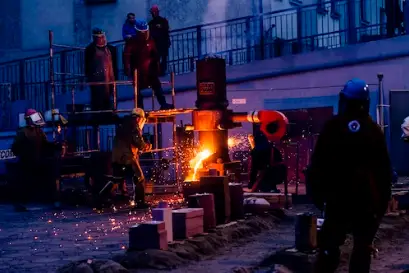In this article, I will share the types of burners used to burn oil fuel (liquid fuel) and their working principles.
When it comes to burning liquid fuels different approach has to be used.
Liquid fuels will always be burned in a fired chambered furnace whereas solid fuels will be burned on the grate-fired furnaces.
The fired chambered furnaces are used to burn pulverized coal, liquid and gas fuels.
You might like this: Pulverized Fuel Burner: Components, Types, Requirements and Working Principle
The liquid fuels are burnt by means of a burner since it’s impossible to spill the fuel on a grate furnace and let it burn effectively.
The main function of the burner is to atomize (breaking the fuel oil particles hydrogen and carbon into very small droplets) to be able to mix it with the proper amount of air for the combustion to be complete.
You might like this: Conditions For Proper Burning (Combustion) Of Fuel
Without the atomization of the oil fuel, there won’t be complete combustion because of insufficient air.
And the kind of flame that will be produced will be full of soot and low energy value.

Types Of Burners Used To Burn Oil Fuel
There are two types of burners used to burn oil fuel which are namely;
- Vaporizing burners
- Atomizing burners
Vaporizing burners
As the name suggests, these types of burners vaporized fuel by heating it.
Atomizing burners
These types of burners first split the oil fuel into very fine particles to increase the surface area for it to be mixed with a sufficient amount of air that will result in complete combustion.
Classification Of Vaporizing Burners And Their Working Principles
The vaporizing burners are further classified into the following categories;
- Rotating cup-type oil burner
- Atmospheric pressure atomizing burner
- Recirculation oil burner
- Wick type burner
1. Rotating cup-type oil burner
The burner sprays oil on a fast-rotating cup that breaks the oil film at the rim due to the centrifugal force.
During the breaking of the oil film at the rim, secondary air is added while the rotating cup spins in the opposite direction.
After that, the oil is ejected out through the spray cone under a considerably high velocity and burns while suspended in the air.
2. Atmospheric pressure atomizing burner
This type of burner depends on the atmospheric pressure to pressurize the oil inside the nozzle tip to atomize it and spray it as a fine mist of oil.
The primary air is added during the atomization and secondary air is added when the oil is about to leave the nozzle to create proper turbulence for the oil to burn completely.
The fine mist of oil ejected from the nozzle tip is well mixed with air and partly evaporated before igniting in the combustion chamber.
A low-pressure fan is used to supply air to the air tube where the nozzle is located.
3. Recirculation oil burner
The air inlet allows the air to enter the nozzle and mixes with the oil fuel at the mixing unit located near the end of the nozzle. As usual, the nozzle ejects the oil fuel as a fine mist into the combustion chamber.
Before the ejected oil fuel reaches the combustion chamber, it passes through a reaction zone (where the fuel is prepared for ignition) where recirculated gas from the combustion chamber is brought.
Recirculated gas from the combustion chamber decreases the temperature of the flame at the reaction zone and reduces the emission of nitrogen oxides.
The recirculation of combustion gas also enables feedback from the combustion chamber to make changes in the amount of heat energy produced (increase or decrease) depending on the current condition in the combustion chamber.
If the heat energy produced is to be increased, an increase in the mass flow rate of the fuel to the combustion chamber will happen thus increasing the heat output.
An increase of the mass flow rate of oil fuel to the chamber slightly increases the pressure of the combustion chamber and this enables another volume of gasses from the combustion chamber to be recirculated to the reaction zone repeating the same events.
The feedback from the combustion chamber to the root of the reaction zone is what controls the mass flow rate of the oil fuel and thus the heat output to the combustion chamber.
The feedback mechanism that is enabled in the recirculating burner (combustion gas taken back to the reaction zone) affects the flow of air to the reaction zone.
4. Wick-type burner
It absorbs fuel and vaporizes it when ignition is initiated. By vapouring the fuel it enables it to properly mix with the air thus increasing the combustion rate.
The burner also distributes the flame produced.
The flame height from the wick-type burner is controlled by lowering the exposed wick height inside the burner unit using an adjusting mechanism.
The vaporizing burners operate by vaporizing the fuel before ignition happens thus properly mixing it with a sufficient amount of air for complete combustion to happen which ends up reducing the soot formation.
To increase the amount of heat produced by these types of burners, more amount of fuel should be used.
Classification Of Atomizing Burners And Their Working Principles
The atomizing burners are classified as follows;
- Mechanical or oil pressure atomizing burners
- Steam or high-pressure air atomizing burners
- Low-pressure air atomizing burners
Mechanical or oil pressure atomizing burners
It atomizes the oil mechanically by using an atomizer into a fine uniform spray which will enable the fuel to burn with minimum excess air.
Mechanical spraying can be achieved in the following ways;
- Forcing the oil under pressure to pass through a very small opening or orifice (in the case of a nozzle).
- Pressurized steam or air can also be used to break up the oil into fine uniform spray.
- Another way that mechanical spraying can be achieved is by using centrifugal force to break the oil into tiny drops.
An air register is used to supply air needed for combustion while a diffuser located at the end of the atomizer is used to stabilize the flame thus preventing it from being blown away from the tip.
This ensures the flame hits the right place thus increasing the heating efficiency.
Mechanical atomizing burners have a burner throat opening at the end of the burner assembly that is made up of refractory and circular and aligned with the burner outlet.
Its main function is to ensure that the flame leaves the burner sufficiently to avoid striking.
Steam or high-pressure air atomizing burners
The steam atomizing burners are of two types namely;
- Outside mix type.
- Inside mix type.
The outside mix type
The oil is ejected through an outside hole and another hole pointed in the same direction where the oil is ejected a high-velocity jet of steam is pointed to break up the oil into small particles.
The oil is atomized by the nozzle and then mixed with the steam outside the burner.
The mixing of the steam and oil takes place outside of the burner thus the name outside mix type.
Inside mix type.
The inside mix type ejects oil through the inside hole and the high velocity steam is also released inside the burner.
The mixing happens inside the burner before the mixture is fed into the furnace while atomization of the mixture happens at the nozzle outlet.
The inside mix-type burner operates with higher efficiency than the outside mix-type burner since they provide a high firing rate.
The steam is pressured to provide high blasting power and mixing.
Low-pressure air atomizing burners
They use low air pressure of between 0.015 and 0.15 bar to atomize the oil. They are simple in their construction.
The low-pressure air is used to blast the oil to facilitate mixing and break the oil into fine particles that are to be sprayed into the furnace.
Lastly…
This is just a summary of the oil burners used in power plants. There is more to learn about their efficiency, design and construction.
If you want to know more about that you will have to research and find helpful resources that will help you out.
Thanks for reading, if you have any questions about what I have shared leave a comment.
See you in my next article.
Related articles to read.
- Fluidized Bed Combustion (FBC): Types, Working Principle & Advantages and Disadvantages
- Pulverized Fuel Burner: Components, Types, Requirements and Working Principle
- 5 Systems Of Ash Handling: Components And Their Working Principles
- Pulverized Coal Firing: Central System, Components, Working Principle & Advantages and Disadvantages
- Factors Influencing Size And Shape Of A Furnace


